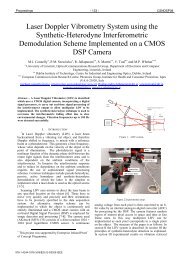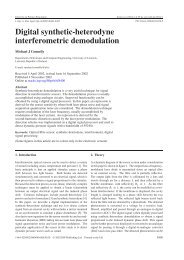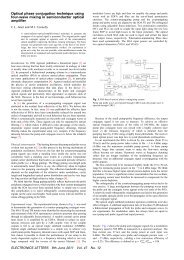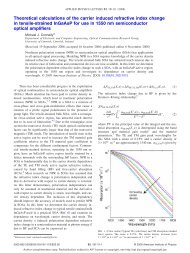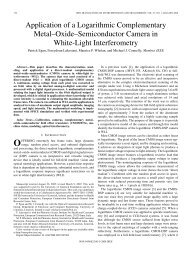Modeling of Semiconductor Optical Amplifier RIN and Phase Noise ...
Modeling of Semiconductor Optical Amplifier RIN and Phase Noise ...
Modeling of Semiconductor Optical Amplifier RIN and Phase Noise ...
You also want an ePaper? Increase the reach of your titles
YUMPU automatically turns print PDFs into web optimized ePapers that Google loves.
NUSOD 2011<strong>Modeling</strong> <strong>of</strong> <strong>Semiconductor</strong> <strong>Optical</strong><strong>Amplifier</strong> <strong>RIN</strong> <strong>and</strong> <strong>Phase</strong> <strong>Noise</strong> for<strong>Optical</strong> PSK SystemsM.J. Connelly 1 <strong>and</strong> C.L. Janer 21 <strong>Optical</strong> Communications Research Group, Dept. Electronic <strong>and</strong> Computer Engineering, University <strong>of</strong>Limerick, Limerick, Irel<strong>and</strong>. E-mail: michael.connelly@ul.ie.2 Department <strong>of</strong> Electronic Engineering, Escuela Superior de Ingenieros, Universidad de Sevilla,Camino de los Descubrimientos s/n, Seville, Spain. Email: janer@zipi.us.esAbstract- <strong>Phase</strong> modulation schemes are attracting muchinterest for use in ultra-fast optical communication systemsbecause they are much less sensitive to fibre nonlinearitiescompared to conventional intensity modulation formats.<strong>Semiconductor</strong> optical amplifiers (SOAs) can be used to amplify<strong>and</strong> process phase modulated signals, but with a consequentaddition <strong>of</strong> nonlinear phase noise (NLPN). Existing SOA NLPNmodels are simplistic. In this paper we show that a more accuratemodel can be used, which results in simple expressions for SOAnonlinear noise, in particular when used to amplify differentialphase shift keyed (DPSK) modulated data. The model is used tocalculate the optical signal to noise ratio introduced by a powerbooster SOA <strong>and</strong> the first inline amplifier <strong>of</strong> a 40 Gb/s NRZ-DQPSK single channel link.I. INTRODUCTION* Constant envelope modulation formats, in particular RZ<strong>and</strong>NRZ-DPSK, are among the most promising c<strong>and</strong>idates forSOA-based high bit rate systems because <strong>of</strong> their resilience t<strong>of</strong>iber non-linearities <strong>and</strong> pattern effects [1]. Gain saturation inSOAs introduces NLPN that can be detrimental in PSKsystems. The phase noise behaviour <strong>of</strong> saturated SOAs inDPSK systems has been analysed in several papers [2 <strong>and</strong> itsreferences]. The advantage <strong>of</strong> these NLPN models is that theyare analytical <strong>and</strong> easy to apply, however they have limitedaccuracy, in that they do not consider the internal noisegenerated by the SOA or properly account for scattering losses.In this paper we show that these assumptions are not alwayscorrect. We also show that an existing computationally simple<strong>and</strong> more accurate noise model can be used that leads to simpleNLPN expressions at the SOA for constant envelopemodulation schemes [3].II.THEORYThe model equations in the spectral domain (ω) are [3]:2z gS() z ρS()z2S S S∂ δρ() δρ()z=− + N∂ z ρ () z 1 + ρ () z + iωτ ρ () z∂δφαg z z z= + N∂ z 1 + ρ ( z) + i ( z)2S( ) ρS( ) δρ( )2Sωτ ρSφ( ω,z)ρ( ω,z)* This research was supported by the Spanish Department <strong>of</strong> Education underthe Programa Nacional de Recursos Humanos del Plan Nacional de I+D+I2008-2011 <strong>and</strong> Science Foundation Irel<strong>and</strong> Investigator Grant 09/IN.1/I2641.(1)(2)where z is the distance from the SOA input, ρ S (z) is the signalfield amplitude (equal to the square root <strong>of</strong> the optical power tothe SOA saturation energy), δρ(z) the amplitude noise(induced by the Langevin force N ρ (ω,z)), δφ(z) the phase noise(induced by the Langevin force N φ (ω,z)), g S (z) the saturatedgain, τ is the carrier lifetime <strong>and</strong> α the linewidth enhancementfactor. The Langevin forces account for field fluctuations dueto spontaneous emission, carrier noise <strong>and</strong> a term arising fromtheir interaction. The terms ρ S (z) <strong>and</strong> g S (z) are the unperturbed,distributions along the SOA <strong>and</strong> can be obtained bynumerically solving [3],∂E( z) 1= gS( z) ( 1 − iα)− γSCE( z)∂ z 2(3)[ ]2= go −gS z τ − gSz E z τ(4)0 ( ) ( ) ( )[ φS]E( z) = ρ ( z)exp i ( z)Swhere φ s (z) is the optical field phase, g o is the unsaturated gain,<strong>and</strong> γ sc the waveguide scattering losses. Once the spatialdependency <strong>of</strong> g S (z) <strong>and</strong> ρ S (z) have been determined, they canbe inserted in (1-2), which are then numerically solved todetermine the SOA output <strong>RIN</strong> <strong>and</strong> phase noise, due to thenoise <strong>of</strong> the input signal, spontaneous emission noise, carriernoise <strong>and</strong> the cross-correlation between the carrier noise <strong>and</strong>spontaneous emission. The numerical solution <strong>of</strong> (1-2) is notdifficult as it mainly involves numerical integration.III.NUMERICAL ANALYSISThe geometrical <strong>and</strong> material parameters used in the modelwere determined for a 1 mm long tensile-strained SOA [4] witha 20 dB unsaturated gain, α = 2.5, saturation power <strong>of</strong> 1.9 mW,g 0 = 9500 m -1 <strong>and</strong> γ sc = 4500 m -1 . Simulation results for SOAoutput <strong>RIN</strong> <strong>and</strong> phase noise for an input signal powernormalised (to the saturation power) <strong>of</strong> 0.1, with no input <strong>RIN</strong>is shown in Figs. 1-2. The phase noise spectrum can be used todetermine the phase noise variance σ φ 2 after optical reception.For example if we consider a 40 Gb/s NRZ-DQPSK receiver,its b<strong>and</strong>width is typically 20 GHz. σ φ 2 can be determined byobtaining the autocorrelation function R(τ) <strong>of</strong> the filtered phasenoise by taking its inverse Fourier transform <strong>and</strong> letting τ = 0.(5)978-1-61284-878-5/11/$26.00 ©2011 IEEE95
NUSOD 2011It is simple to carry out this numerically. In Fig. 3, σ φ is plottedversus the normalised input power. It can be seen that σ φ isquite sensitive to the degree <strong>of</strong> saturation. To our knowledgethe probability density function <strong>of</strong> NRZ-DQPSK r<strong>and</strong>om datain the presence <strong>of</strong> NLPN has not yet been determined <strong>and</strong> so itis not presently possible to obtain an analytical expression forthe bit-error-rate. However it is possible to determine the<strong>Optical</strong> Signal-to-<strong>Noise</strong> Ratio (OSNR) which is given byOSNR = π 8σ(6)2 2φIn Fig. 4, the OSNRs at the outputs <strong>of</strong> a power booster (with noinput noise) <strong>and</strong> a first in-line SOA in a 40 Gb/s DQPSK linkare shown as a function <strong>of</strong> the SOA carrier lifetime. Both SOAinput normalised powers are equal to 0.01. It can be seen thatthere is a serious degradation in the OSNR, particularly at thein-line SOA output, for small carrier lifetimes. Similarsimulations show a similar dependency for increases in thelinewidth enhancement factors <strong>and</strong> scattering losses.Fig. 2: SOA output total phase noise <strong>and</strong> components spectra (centred at theoptical frequency) for a normalised input power <strong>of</strong> 0.1.REFERENCES[1] A.H. Gnauck <strong>and</strong> P.J. Winzer, “<strong>Optical</strong> phase-shift-keyed transmissions,” J.Lightwave Techol., vol 23, pp. 115-130, 2005.[2] X. Wei <strong>and</strong> L. Zhang, “Analysis <strong>of</strong> the phase noise in saturated SOAs forDPSK applications,” IEEE J. Quantum Electron., vol. QE-41, pp. 554-561, 2005.[3] M. Shtaif, B. Tromborg <strong>and</strong> G. Eisenstein, “<strong>Noise</strong> spectra <strong>of</strong> semiconductoroptical amplifiers: relation between semiclassical <strong>and</strong> quantumdescriptions,” IEEE J. Quantum Electron., vol. 34, pp. 869-878, 1998.[4] M.J. Connelly, “Wide-b<strong>and</strong> steady-state numerical model <strong>and</strong> parameterextraction <strong>of</strong> a tensile-strained bulk semiconductor optical amplifier,”IEEE J. Quantum Electron., vol. 43, pp. 47-56, 2007.Fig. 3: SOA output phase noise st<strong>and</strong>ard deviation for input powers rangingfrom 0.01 to 0.1. The receiver b<strong>and</strong>width is 20 GHz.Fig. 1: SOA output total <strong>RIN</strong> <strong>and</strong> components spectra (centred at the opticalfrequency) for a normalised input power <strong>of</strong> 0.1.Fig. 4: OSNR at the output <strong>of</strong> SOA power booster <strong>and</strong> the first in-line amplifieras a function <strong>of</strong> the carrier lifetime for a normalised input power = 0.01. Thereceiver b<strong>and</strong>width is 20 GHz.96


